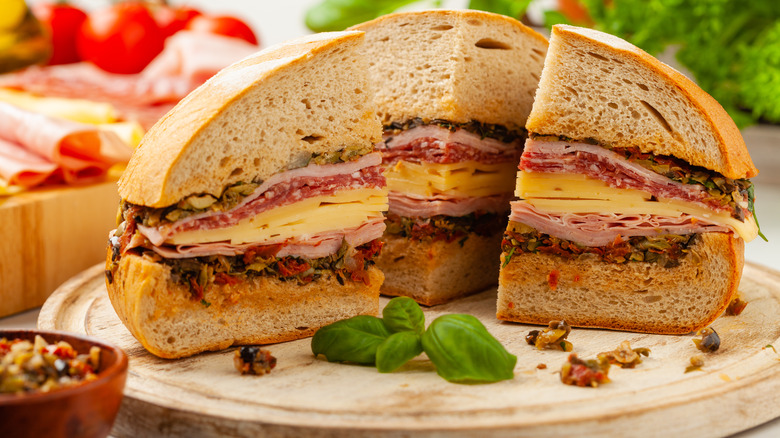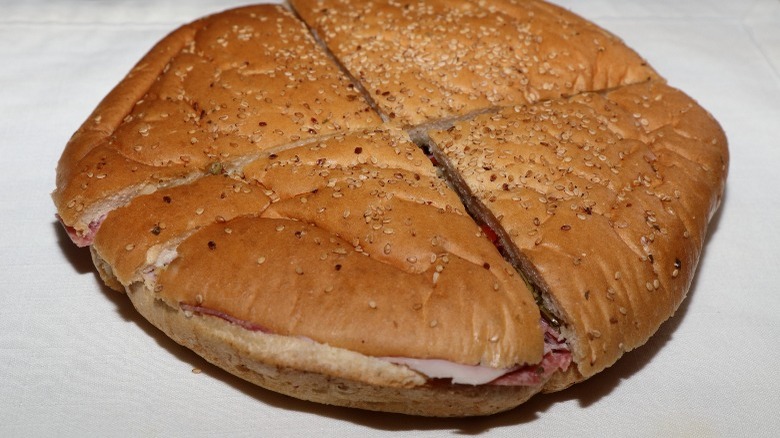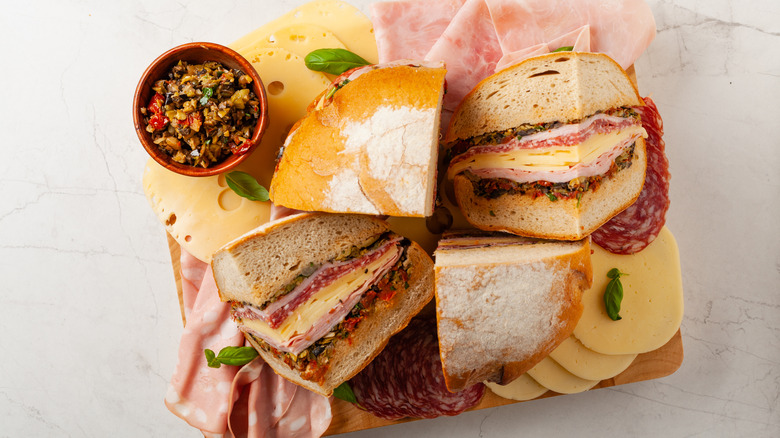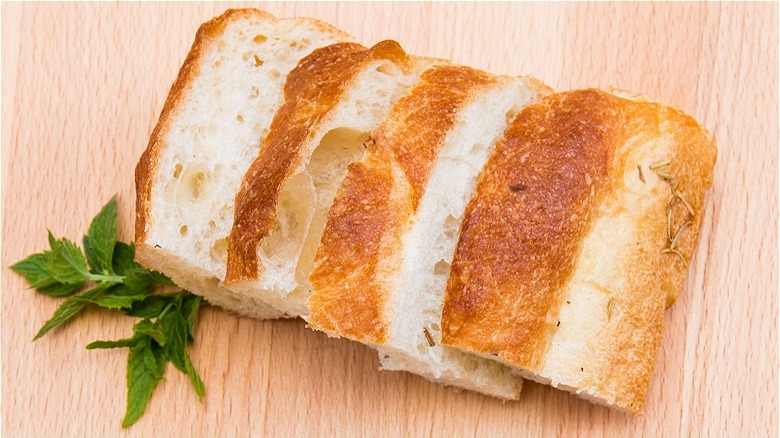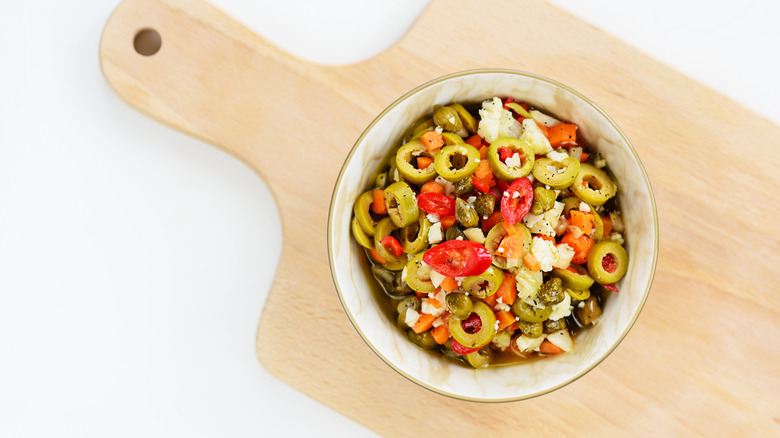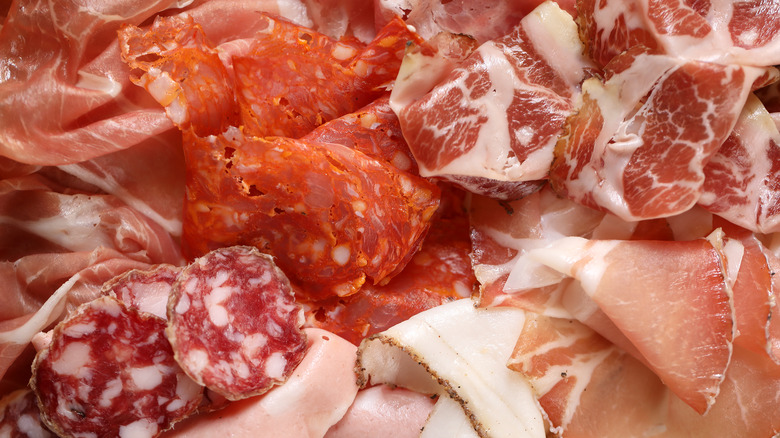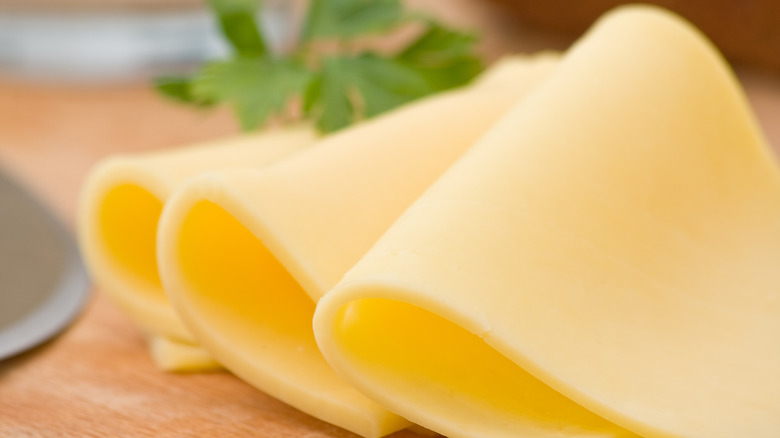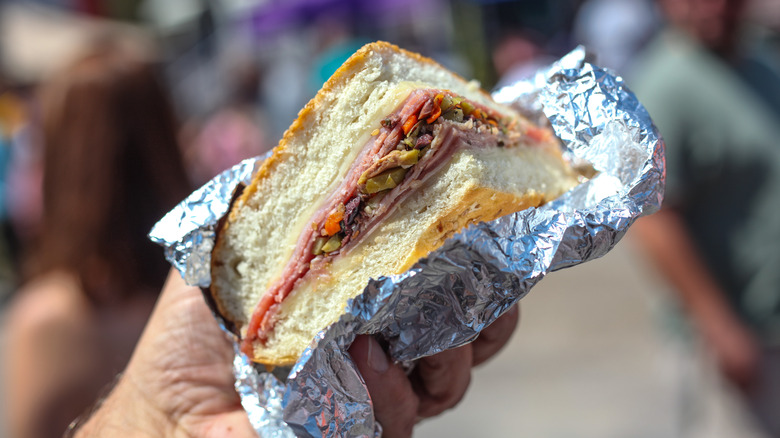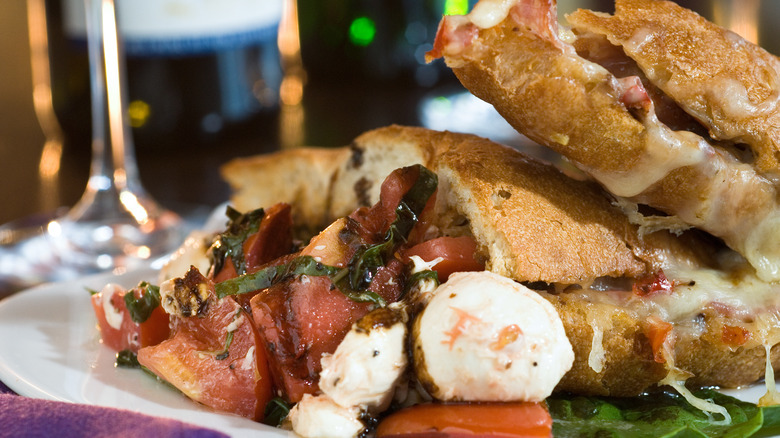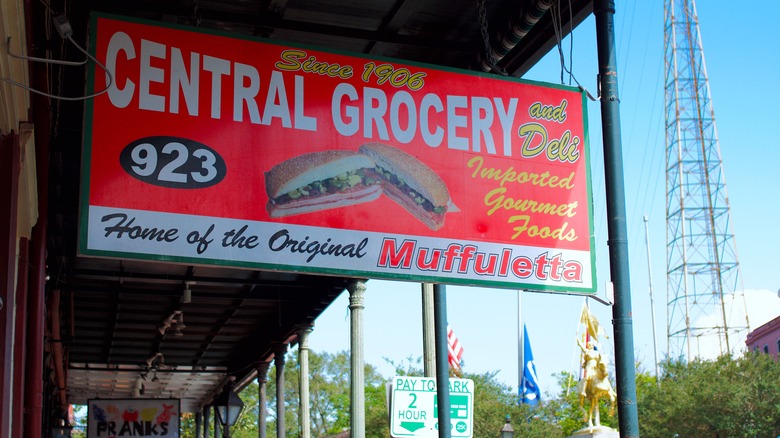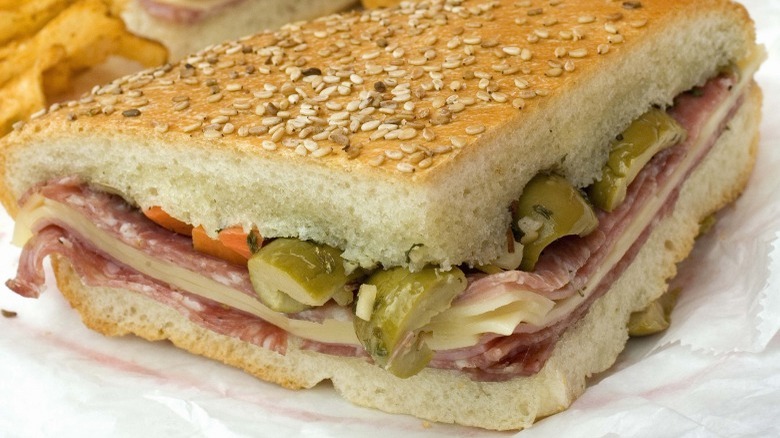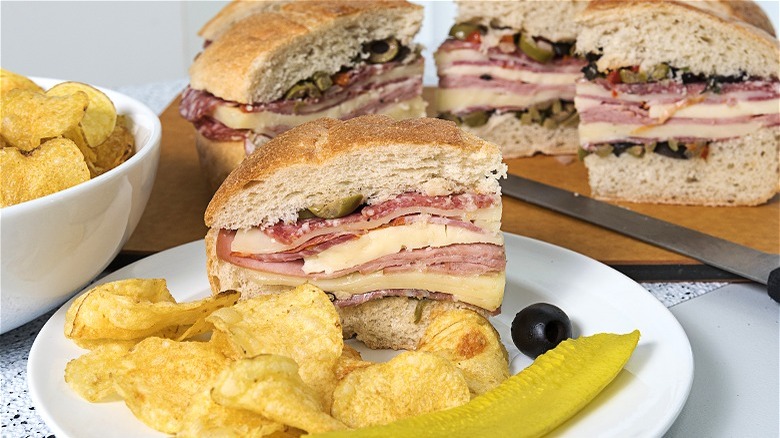The Ultimate Guide To New Orleans Muffulettas
From its inception, New Orleans has been a city of cultural fusion. Centuries of being a key trading port made the city a high-traffic zone, where many different peoples intersected. People brought with them their own culinary traditions, which then made a mark on the local cuisine.
New Orleans is well known for Creole food. This style has West African, Spanish, French, Caribbean, and Native American influences. Together, these diverse cultures made an impact on the culinary culture. Along with Creole cuisine, Sicilian cuisine is also an influential part of New Orleans food history. One of the city's signature dishes, the muffuletta sandwich, has Sicilian roots.
In addition to the po'boy, the muffuletta is an iconic New Orleans sandwich. It is salty and tangy, thanks to its unique olive-based condiment. It's also made with savory Italian meats and cheeses. All of this gets piled high on a large round loaf. It may seem fairly simple, but the sandwich is actually somewhat complex. Here's a deep dive into the New Orleans muffuletta.
It's a historic, Italian-American invention
The name muffuletta comes from the bread that the sandwich is built upon. This particular style of bread hails from Sicily. It was influenced by Sicilian immigrants that settled in New Orleans during the 19th and 20th centuries.
The commonly held origin story says that freshly-baked loaves of muffuletta bread were sold alongside meats and cheeses at a New Orleans shop in the French Quarter neighborhood. The shop was called Central Grocery. Its owner, Salvatore Lupo, offered to make things easier for his customers by combining all of the elements sold at his store together. This meant putting bread, cheese, cold cuts, and his own special olive spread on muffuletta bread. Thus, the muffuletta sandwich was born.
Other stories dispute this tale, so we may never know exactly where this sandwich got its start. But however it came to be, the sandwich was a hit. Its popularity endures to this day. It is not the easiest item to spell or pronounce, but struggling with the name is worth it, to enjoy a delicious piece of New Orleans culinary history.
There are a few key components
While the distinctive bread is what makes a muffuletta, it is the fillings that give the sandwich its flavor. There are three elements that go in between the sliced halves of the loaf: meat, cheese, and a tapenade-like relish known as Italian olive salad. These three pillars balance one another beautifully, especially if the sandwich is created with the perfect ratios in mind.
The olive salad should be laid directly onto the bread. This way, it soaks into the loaf's interior, moistening the bread and infusing a briny flavor into each bite. Generous piles of various Italian cold cuts and sliced cheeses are then layered on top of the olive spread.
Other typical sandwich fillings — like lettuce and tomato — can optionally be added. But these are less traditional. Since the classic muffuletta loaf is so large in diameter, it's usually cut into smaller sections, making it easier to share and eat.
Bread
Much like New Orleans, Sicily was a historic trading hub. The island drew people from all over the Mediterranean and beyond, who then influenced the island's culinary traditions. The muffuletta loaf — the original Sicilian bread for which the sandwich is named — is also historic. It has been around since ancient Roman times.
The round, soft loaf — often topped with seeds — is not just appreciated for its taste and texture. It has also played an integral part in Sicilian culture. Two religious holidays, the Day of the Dead and the Feast of the Immaculate Conception, feature muffuletta bread.
This bread can be eaten on its own. But it is also often stuffed with fillings, like olive oil, cheeses, and sardines. While the sandwich itself did not originate in Sicily, it's easy to see the connection between the original Italian muffuletta and the modern-day American version, thanks to these similar ingredients.
A classic muffuletta loaf can be hard to come by outside of Sicily and New Orleans. If you can't track it down and don't want to bake your own, you can substitute it in other loaves. Ciabatta makes a decent alternative, as long as the crust is firm enough to handle the moist filling.
Olive salad
Somewhere between giardiniera and tapenade lies Italian olive salad, the mixture that serves as the flavor base for the New Orleans muffuletta sandwich. Italian olive salad is typically chopped rough, unlike tapenade which is smoothed to the consistency of a thick spread. Unlike giardiniera, which is made from a mixture of pickled vegetables, olive salad mainly consists of olives.
There's no one exact recipe for Italian olive salad, so if you're making your own, do not be afraid to experiment and adjust to your personal taste. It's also available to purchase in grocery stores, or online, from specialty Italian food vendors.
Olives make up the bulk of this ingredient. They are chopped or sliced, then tossed in a dressing of olive oil and an acidic element (such as lemon juice or vinegar). Any type of olive, or combination of olives types, can be used. To punch up the brininess, consider adding capers or anchovies. Minced onion and garlic can also be included for their sharp, bright flavor. Pickled peppers can add heat. Fresh or dried herbs — like oregano, parsley, and freshly cracked pepper — can be mixed into the dressing for more dimension. This muffuletta olive salad recipe is a good place to start.
Meats
Most Italian sandwich meats are fair game for use in a muffuletta. Combining flavors and textures will give you the most complex and interesting sandwich. Most recipes call for three meat elements: a salami, a cured ham, and a mortadella or bologna. These are not hard and fast rules. If you are making your own muffuletta, feel free to mix and match meats.
Mortadella or bologna provide a soft, tender layer of meat. Cured hams like prosciutto add a savory, fatty, and rich element. Salami gives the sandwich a nice and chewy texture.
Playing around with salami styles can completely change your muffuletta flavor profile. Opt for spicy soppressata or calabrese if you like heat, or finocchiona if you enjoy a more aromatic and herbal flavor. Peppered salami adds a nice bite of spice. Tartufo salami — a type of cured meat that is made with truffles — gives your sandwich a luxurious umami character.
No matter which meats you use, always opt for the highest quality. Also, get them sliced by hand so you know they're freshly cut.
Cheeses
The cheese element of a muffuletta is somewhat more straightforward than the other significant ingredients. Provolone is a safe bet for this Italian sandwich. This semi-hard cow's milk cheese originated in southern Italy and versions of it are now made around the world. Its mildness makes it an ideal sandwich cheese, as it adds just the right amount of soft dairy flavor without taking over. This mildness also provides a slight contrast to the tangy, saltiness of a muffuletta's olive salad and meats.
Any semi-firm cheese that's relatively mild and easy to slice will do. This includes options like mozzarella, asiago, fontina, or scamorza. You don't have to stick to solely Italian cheeses, either. Swiss cheese, for example, can also work. Also, you can feel free to mix and match cheeses to create the most exciting flavor combinations.
Since a traditional muffuletta is served at room temperature, do not worry about cheese meltability. However, some New Orleans establishments do serve their muffulettas heated.
How to eat a muffuletta
A traditional muffuletta — made with classic muffuletta bread — will usually be served quartered. Each quarter is typically big enough to be considered a single sandwich serving. Outside of New Orleans, real muffuletta loaves can be hard to find. If you are elsewhere, you may have a muffuletta-style sandwich made on ciabatta and similarly sliced into sections. In other cases, a muffuletta may even be made on an individual sandwich roll like a hoagie.
A properly crafted muffuletta will have been left to sit for a while before serving, so that the oily goodness of the olive salad can seep its way through the bread, giving each bite maximum flavor. That's why you'll often get your sandwich wrapped in paper, foil, or both. This way, the moistness stays put and doesn't ooze out onto your hand. The pointed triangular shape of each quartered muffuletta slice makes it easy to get that perfect initial bite, before making your way to the wider curved end of the loaf, which will have sopped up all of the remaining tangy olive flavors. Even when wrapped, a muffuletta can be messy, so make sure you're ready with plenty of napkins.
Variations on the classic
There is debate over what makes a muffuletta truly authentic. Every establishment in New Orleans and beyond has its own unique recipe. While these businesses usually share the same basic ingredients, there are a few nuances in the crafting of the sandwich that set them apart. Such nuances can cause serious contention among fans of one style or another.
Devotees of the muffuletta can't seem to agree on whether the sandwich should be served hot, cold, or somewhere in between. Central Grocery, the sandwich's presumed birthplace, proudly and confidently serves it cold. Cochon Butcher, another esteemed New Orleans establishment, serves it hot. Other muffuletta spots, such as Katie's Restaurant, go somewhere in the middle, toasting the bread but leaving the rest of the sandwich unheated. Many establishments will offer diners the option of having their sandwich heated or not, leaving it up to the guest to decide what style is best.
Other variations abound, using alternative fillings such as seafood. There are muffuletta-inspired pizzas, open-faced versions, tiny versions like these mini muffulettas, and muffuletta salads which give you all the ingredients except the bread. Traditionalists will surely shake their heads at these variations, but the muffuletta's flavors are so good that it's hard to fault anyone for making them into new and innovative forms.
The best muffulettas in New Orleans
To get the true muffuletta experience, there's no substitute for eating the real thing in New Orleans. You'll find muffulettas throughout the city. But the best place to start is where it all began: Central Grocery in the French Quarter neighborhood.
The iconic establishment had to temporarily close after Hurricane Ida. But that hasn't stopped them from continuing to make their world-renowned sandwiches and distributing them elsewhere while they rebuild. If you can't make it to New Orleans, Central Grocery's delicious muffuletta sandwiches are available for purchase through the food website Goldbelly.
There are also plenty of other New Orleans institutions known for their muffulettas. A similar eatery, Cochon Butcher, is well-known for its meats. The business butchers and cures this sandwich component itself. Napoleon House is another classic spot. Like Cochon Butcher, this business heats its muffulettas. It believes that this helps to bring out more flavor. Right down the street from the original Central Grocery location, you'll find another toasted muffuletta option at Frank's Restaurant. Verti Marte — a French Quarter corner shop that's open all day and night — offers muffulettas either hot or cold, both surely satisfying options after a night of New Orleans revelry. An intrepid culinary adventurer could make an entire day out of exploring the city's different muffuletta hotspots.
The best muffulettas outside of New Orleans
If you can't make it to New Orleans but are hit with a muffuletta craving all the same, there are some spots scattered throughout the rest of the United States that are worth checking out. These many businesses may not be strictly authentic — a New Orleans native will likely tell you that muffulettas just are not the same outside the city — but these other eateries are there for you when you need your muffuletta fix.
One state over, there's such a spot worth checking out. Jimmy's Food Store — located in Dallas, Texas — is an Italian deli known for its muffulettas. They make their own olive salad, which they pile on generously. Over in St. Louis, Blues City Deli makes a massive muffuletta. This local Missouri spot piles its sandwiches high with all of the classic ingredients. Not too far from the muffuletta motherland is Anthony's Italian Deli. This Baton Rouge, Louisiana spot makes a famed muffuletta that's pressed and heated so it becomes condensed and melty. You can even find a more authentic version all the way up in Chicago, at the Italian sandwich shop Rosie's Sidekick. Even West Coasters can get in on the muffuletta action, at the Sicilian deli Sebastiano's. This Portland, Oregon spot uses locally-made meats piled atop their own in-house baked muffuletta loaf.
No matter where you are in the country, a quality muffuletta is likely within reach. It's always well worth the journey to get one.
Tips for making your own
The best way to ensure that you're never far from a muffuletta is to learn to make your own, in the comfort of your own kitchen. If you're lucky enough to have a nearby supplier of muffuletta loaves, you are already halfway there. If not, you can always break out your baking gear and give it a try yourself. Even without the truly authentic bread, you can always keep the fillings on hand, and substitute whatever bread you have around to make a satisfying substitute.
Making your own olive salad is also a fairly easy task. Once it's done, your salad will last a decent amount of time in the refrigerator, especially if you ensure the solid bits are completely submerged in the oil mixture. Of course, if it looks moldy or smells off, makes sure to get rid of it no matter how long it's been in there. Once you've got the bread and olive salad covered, all that's left are the meats and cheeses of your choosing.
The nice thing about making your own muffuletta is being able to customize every element to your liking. Make your olive salad as zesty, mild, or spicy as you like. No one will judge you if you prefer it heated or cold. You can also pile as many layers of meat and cheese on as you wish. Use this recipe for a tailgate muffuletta sandwich as a jumping-off point, and then let your imagination guide you.
